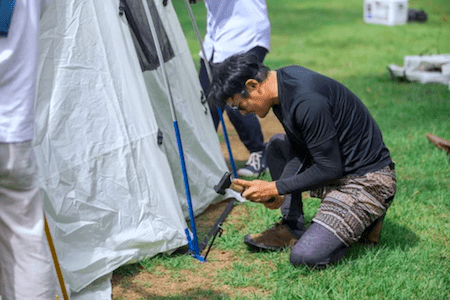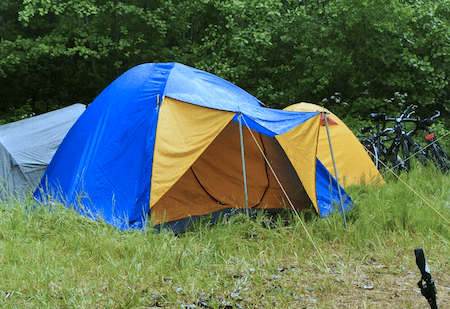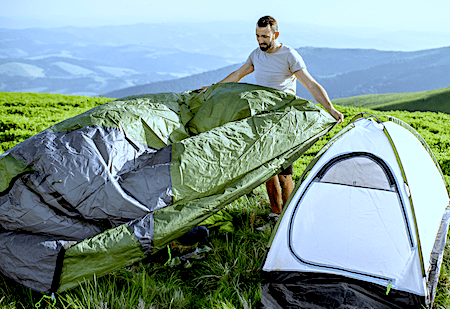You’ve found that perfect camping spot, you’ve pitched your tent, and now all you want to do is sit back and enjoy the beautiful surroundings.
Then suddenly, something feels off. The feel of the wind just doesn’t sit right with you.
And you can’t seem to shake it off that feeling that winds are picking up, and it won’t be long until a gust blows your precious little home away from you.
However, that doesn’t have to keep you from camping at all, so long you know how to secure a tent in high winds.
While it may seem like a tall order, with a bit of knowledge and planning, you can enjoy a night beneath the stars without worrying about windy nights.
Read ahead to learn more.
A Guide To Securing Your Tent In High Winds
Here, we have outlined everything you need to know to keep your tent secure in high winds.
#1. Choose Your Camping Gear Wisely
A neat setup of your tent will do little in keeping it upright against gusty winds if you don’t use the proper equipment.
That’s why choosing the right gear is the first step toward securing your tent in high winds.
Below are several things to consider.
Invest In Quality Gear
When you use reliable and high-quality camping gear, your tent will be less likely to be affected by high winds.
Your tent must be strong enough to hold up to windy conditions. If you’re concerned about cost, buy secondhand rather than buying a cheap brand.
If available, you may want to check the product’s wind ratings, too.
It’s essential to invest in heavy-duty tent pegs and guy ropes, at least in areas more exposed to the wind, like the awnings.
Consider purchasing quality extras if those with your tent are of poor quality.
Smaller Tents Might Be More Suitable
By having an aerodynamic camping setup, the wind will have less trouble moving around without dragging everything with it.
So, you may want to give it some thought before purchasing an enormous multi-room tent and consider smaller tents instead, which have lesser surface area.
Even though larger tents are more comfortable, the aerodynamic aspect is quite a tradeoff as far as wind is concerned.
Besides, your pegs and stakes should do a better job handling a smaller one than a big one.
Bring a Tent Repair Kit
If you plan on camping in high winds, you should know what type of tent you have, its age, and how much damage it can sustain.
Then it’s a good idea to pack camping tools needed for running repairs; for instance, a tent repair kit, spare poles, duct tape, tent hubs, repair manuals, etc.
#2. Actions To Take In The Campground
Following your arrival at the campground, here are the steps you should take for a successful tent set up in high winds.
Pick A Sheltered Campsite
Look for a camping spot well-sheltered from strong winds when you’re looking for a good site.
For example, hillsides, bushes, wooded areas, caravans, hedges, motorhomes, and even other tents make excellent windshields when conditions worsen.
Having trees as a windbreak can also be helpful. However, be careful to avoid camping directly beneath the branches.
Face The Least-Wide Side Toward The Wind
Take the time to detect the wind’s direction. You can either feel the wind on your face or use some fabric to determine which direction the wind is blowing.
Once you find that out, place the tent’s smallest and lowest side toward the wind so it hits a reduced surface area.
Keep The Tent’s Front Facing Away From The Wind
Likewise, you must position your tent’s front side away from the wind so that the windy gusts won’t blow it around like a sail.
At the very least, take down the tent vestibule and keep the door shut if the wind changes.
Pitch Your Tent With Proper Pegging And Guying Out
Pitching your tent appropriately is undoubtedly the most crucial part of all.
If you plan to stay in high wind for some time, here’s what you need to remember when staking your tent.
- First, be sure to follow the instructions on the user manual for pitching your tent with all the pegs and guy lines.
- You should hammer the pegs at a 45-degree angle. You want them to face away from the tent instead of vertically, so they’ll be more resistant to wind pressure.
- Likewise, angle the guy lines at 45 degrees (more if possible) away from the pole to increase stability.
- Instead of pegging multiple guy lines to the same point, use an individual peg for each.
- Ensure the corners of an awning that are susceptible to damage have two guy ropes attached.
Stabilize Your Tent Setup
Your tent probably came with a few guy lines, yet there’s no harm in adding more, especially in windy conditions.
So, feel free to prepare your tent for the high winds by tying up more guy ropes.
You might be in luck if you choose to camp near or on some rocky area during high winds.
You can then stack a few large rocks near your tent and tie some guy ropes to them to enhance stability.
If you don’t have stakes or have broken stakes, read this article.
How To Stop Your Tent Flapping In The Wind
Sometimes, the wind blows hard enough to cause the tent sides or bottom edges to flap with excessive noise, even after securing it well.
And it’s needless to say how irritating that can be when you try to sleep. So, here are some tips that may help ease the problem.
Tie A Few Knots
Tie knots on the tent’s edges where the fabric might be splaying loosely and tighten it until you have them straightened out.
You can use sailor knots to ensure easy undoing.
Set The Guy Lines Afar
Flapping can also occur when you’ve tied the guy lines closer to one another, for it keeps the sidewalls from standing taut against each other.
Ideally, you should tie them down at least 1.5 meters away from the tent’s base.
Place A Tarp Over The Tent
Covering the tent with a tarp is an excellent way to stop the flapping for good.
You can have a more secure setup if the tarp is large enough to cover some of the surrounding areas, and you weigh the ends down with some rocks.
Attach A Rainfly
A rainfly may also come in handy for reducing the flapping if you attach it to the pole tops using zip ties or velcros.
But instead of placing it on top of your tent, you’ll want it to angle it against the wind’s direction, so it acts as a barrier.
How To Take Down Your Tent In High Winds
The taking down process is pretty much the reverse of the setup. However, a few additional precautions might help keep your stuff from getting blown away.
Firstly, you’ll want to gather up the small items that can blow away with the wind. You can then weigh them down with rocks before turning your attention elsewhere.
Secondly, it’s a good idea to place a few rocks over the loose ends of the tent before taking out the pegs. If you do so, you won’t have to run frantically after your tent as it would otherwise fly away with the wind.
Also, consider how best to proceed with your actions and what could happen when undoing the fittings or lifting a weighted stone.
And finally, make sure you tidy up your camp – return everything to its rightful place.
Frequently Asked Questions
What Wind Speed Can A Tent Withstand?
On average, a quality 2 to 3-season tent can handle wind speeds of up to 17 mph. With an aerodynamic design, especially on expensive high-end models, the resistance will likely reach up to 35 mph.
Can A Tent Withstand 50 Mph Winds?
Probably not.
However, even if one can, it’s not so great an idea to camp in such weather, is it?
Are Tunnel Tents Good In The Wind?
If you pitch a tunnel tent facing the wind, where heavy gusts will hit it, it will likely collapse; it won’t if you do otherwise.
Nonetheless, it sure makes the ideal choice when you have your car with you and have additional room to spare in your tent.
What Should You Use To Stake Canopy Tent Poles In High Winds?
You can use either bungee cords or some thick, sturdy nylon rope to secure the canopy to its stakes.
It’s best to wrap the end of a cord around the canopy’s horizontal bar on the roof’s edge. Start at a corner, and then help the canopy anchor by twisting the rope around its leg.
Thoughts
So there you have it. It may be simple enough to raise or lower your tent when the wind is calm, but things get tricky when the winds pick up, there is a thunderstorm and start to rock your tent.
But now that you know how to secure a tent in high winds, your tent won’t be going anywhere when the strong wind tries to carry it away.
So, be sure to bring these tips along on camping trips or backpacking adventures for that added assurance you seek when the weather gets gusty.




